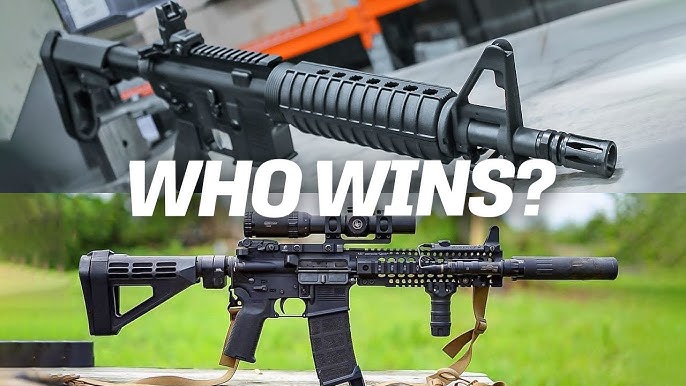When it comes to modern firearms, two rifles often come up in conversations: the AR15 and the M4. While they share several similarities, they have distinct features that set them apart. Knowing the difference between AR15 and M4 is important for anyone interested in firearms, whether you’re a gun enthusiast, a hunter, or someone who just wants to understand the technical details. For a deeper dive into firearms and tactical gear, visit https://falkotactical.com, where you can explore expert insights and high-quality products. In this article, we’ll break down these two rifles to help you see how they compare and contrast.
1. Design Origins and Development
Both the AR15 and M4 share a common ancestor: the AR-15 platform, originally designed by Eugene Stoner in the late 1950s. However, their development diverged based on military and civilian needs.
The AR15 was designed for civilian use and was created to be a lightweight, gas-operated, semi-automatic rifle. It became popular in the 1960s and was sold by companies like Colt to civilians. Over time, it evolved into various models and configurations.
The M4, on the other hand, is a military adaptation of the AR15. Developed in the 1990s, the M4 is a carbine version that was specifically tailored for military operations. It has a shorter barrel, a collapsible stock, and full-automatic firing capability, features that make it more suitable for rapid-response situations in combat.
2. Functionality and Firing Modes
The most significant difference between the AR15 and M4 lies in their firing modes. The AR15 is typically semi-automatic, meaning it fires one round with each pull of the trigger. This is a feature desired by many civilians who want to enjoy a functional, powerful rifle but are limited to non-military models due to legal restrictions.
In contrast, the M4 is capable of both semi-automatic and fully automatic firing. Some versions of the M4 have a three-round burst setting, which allows the user to fire multiple rounds with a single pull of the trigger, making it more versatile in combat situations. This automatic capability is essential for soldiers who need to engage multiple targets quickly.
3. Barrel Length and Overall Size
Barrel length is another key distinction. The AR15 typically has a longer barrel, usually around 20 inches, though this can vary based on the model and customization. The longer barrel improves accuracy over long distances, making it ideal for target shooting or hunting.
The M4, as a carbine, features a much shorter barrel, usually 14.5 inches. This shorter length enhances maneuverability and is particularly useful in close-quarter combat, where a compact firearm is needed. Despite its reduced barrel length, the M4 remains highly effective in various military operations due to its design.
4. Customization and Accessories
Both the AR15 and M4 are highly customizable, but the M4’s design has been optimized for military requirements, meaning it’s equipped with more options for tactical modifications. The M4 often comes with rails on the handguard to accommodate accessories such as scopes, lasers, grips, and tactical lights. Its modular nature allows soldiers to tailor the rifle for specific missions or environments.
While the AR15 also allows for significant customization, civilian versions are generally more limited in their accessory options compared to the M4. However, with aftermarket parts available, it’s still possible to modify an AR15 to suit individual preferences for hunting, target shooting, or home defense.
5. Legal Restrictions and Use
One of the most important aspects to consider when comparing the AR15 and M4 is their legal status. The AR15 is widely available for civilian purchase in the United States, though certain features like the ability to fire in full automatic are restricted under federal law.
The M4, due to its full-automatic capability, is restricted to military use and cannot be legally purchased by civilians. While some versions of the M4 may be available for law enforcement or specialized civilian uses in certain regions, the full-automatic feature remains restricted to the military.
6. Weight and Handling
The AR15 is typically slightly heavier than the M4, particularly because of its longer barrel and fixed stock. This additional weight may provide more stability during firing, but it can also make the AR15 less convenient to handle, especially in situations where mobility is important.
The M4 is specifically designed to be lighter and more compact. Its collapsible stock makes it easier to carry and deploy quickly, particularly in confined spaces. This makes the M4 a preferred choice for military personnel operating in dynamic environments.
7. Cost and Availability
The cost of both rifles varies depending on the manufacturer and the configuration. In general, the AR15 tends to be more affordable for civilians because it lacks some of the advanced features of the M4, such as the automatic firing mode. The base price for an AR15 can range from several hundred to over a thousand dollars, depending on the model and accessories.
The M4, being a military-grade rifle, is typically more expensive, especially when considering versions equipped with advanced features like a fully automatic firing mode or specialized optics. Additionally, availability of the M4 is restricted, meaning it’s not commonly found on the civilian market.
Conclusion
The difference between AR15 and M4 lies in several aspects, from functionality and firing modes to legal restrictions and customization options. While both rifles share a similar origin and basic design, their applications are vastly different. The AR15 is primarily designed for civilian use, offering a semi-automatic experience suitable for recreational shooting, while the M4 is a military-grade rifle built for rapid-response and combat situations.
Ultimately, understanding the differences between these two rifles can help you make an informed decision, whether you’re looking for a firearm for hunting, sports shooting, or gaining a deeper understanding of military equipment.












